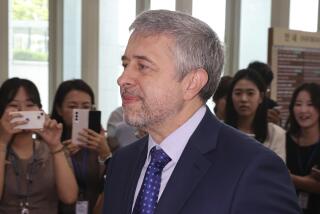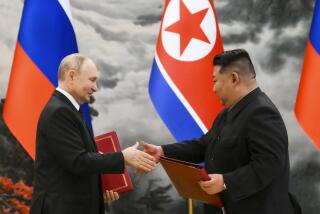For North Korea and the U.S., it’s been threats, sanctions and vitriol. Whatever happened to negotiations?

Was Trump’s “fire and fury” threat against North Korea reckless or calculated? (Aug. 10, 2017)
Why can’t the United States and North Korea just sit down and talk about it?
Over the last year, glimpses of a breakthrough in the long impasse between the two countries have been obscured by anxiety-producing new events — missile and nuclear tests, a bizarre assassination and the cruel death of the American college student Otto Warmbier.
Even talking about what talking would look like has proved complicated.
Nine days after the U.S. presidential election, a pair of former U.S. State Department officials and two North Korean diplomats met discreetly at a hotel in Geneva for talks on how to get their estranged countries negotiating again.
Like others around the world, the North Koreans seemed to be expecting that Hillary Clinton would be the next president, but they were not unhappy with Donald Trump’s victory, according to one of the Americans at the meetings.
“They were surprised at the outcome of the election, but they had an open mind,” said Joel Wit, a veteran North Korea hand who was one of the former U.S. officials who participated. “They were willing to wait and see what the Trump administration would do.”
There was even a slight reason for optimism. During the presidential campaign, Trump had said repeatedly he would be willing to talk directly to leader Kim Jong Un.
“What the hell is wrong with speaking? And you know what? It’s called opening a dialogue,” Trump had said in June of 2016. “If he came here, I’d accept him, but I wouldn’t give him a state dinner like we do for China and all these other people that rip us off when we give them these big state dinners.”
He went on to suggest he would serve Kim “a hamburger on a conference table.’’
The hamburger never materialized.
Shortly after Trump’s inauguration, plans were made for North Korean envoy Choe Son Hui to come to New York for back-channel talks about reopening a more formal dialogue. She was scheduled to arrive on March 1. But events intervened. Two weeks before, Kim Jong Nam, Kim Jong Un’s half-brother, was poisoned to death with VX nerve agent in the Kuala Lumpur, Malaysia, airport in an attack widely blamed on the North Korean government; the State Department canceled the visa for Choe’s trip to New York.
In early May, a meeting finally took place in Oslo between Choe and a group of Americans led by Joseph Yun, the State Department’s deputy assistant secretary for Japan and Korea. That meeting produced what in diplomatic parlance is known as a deliverable: North Korea agreed to release Warmbier, the American college student who had been held for 18 months after allegedly trying to swipe a propaganda poster from the Pyongyang hotel where he was staying as a tourist.
That was good news — except it turned out that the 22-year-old had suffered extensive brain damage while in North Korean custody — for reasons that are still unclear.
Warmbier died in June, shortly after his release. What had been billed by the North Koreans as a humanitarian gesture, intended to warm relations, instead had the opposite effect.
Since then, the North Koreans have conducted two tests of intercontinental ballistic missiles that they say are capable of reaching the United States.
Quiet back-channel talks with the North Koreans have been taking place regularly for years, despite the collapse of official six-nation diplomatic talks in late 2008. But nothing official has been scheduled, in large part because of a disagreement about whether there would be preconditions for the talks set by the United States.
“We are stuck in this no-man’s land. They are not going to have a meeting with preconditions imposed on the meeting,’’ said Wit.
The Obama administration last year had agreed to drop the preconditions for talks to begin, but a tentative deal to negotiate fell apart after the United States in July put Kim Jong Un and 14 other top North Korean officials on a personal blacklist in response to a nuclear test conducted earlier in the year.
At that point, the North Koreans apparently decided that it wasn’t worth their while to bother with a lame-duck president and that they would instead wait for the new administration.
Despite the recent exchanges of threats and bombast, Wit believes the North Koreans are still willing to negotiate. “What they’ve said is that they are open to restarting a dialogue with the new administration and that they are willing to discuss denuclearization, but that these initial meetings have to be without preconditions,” he said.
The U.S. has asked that North Korea make some gesture to show its seriousness, such as pausing the relentless pace of weapons tests. The North Koreans have asked that the United States end its “hostile policy” toward their country by scaling back joint military exercises with South Korea.
Scott Snyder of the New York-based Council on Foreign Relations said he believes that North Korea’s increased pace of weapons testing has been motivated partly by the desire to establish itself as a nuclear power in a position of strength before sitting down to negotiate.
“We are in a kind of pre-negotiating phase where both sides are trying to shape the environment for their own purposes,” Snyder said. “The problem is imagining how that transitions to actual negotiations.”
ALSO
Were Trump’s fiery threats against North Korea reckless or calculated?
Tiny Pacific island finds itself in the crosshairs of North Korea. Why Guam?
More to Read
Sign up for Essential California
The most important California stories and recommendations in your inbox every morning.
You may occasionally receive promotional content from the Los Angeles Times.










